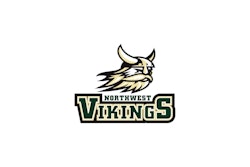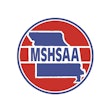This article originally appeared in the March 1988 issue of AB with the headline, “In Search of More Minority Administrators.”
When Jimmy “The Greek” Snyder made his ill-advised remarks about black athletes in January, it struck many as not as surprising that someone would hold his views as that anyone would express them so glibly, without much apparent thought, in front of a microphone and television camera.
It’s no surprise, either, that racial bias continues to exist in America, and it might also be said that the right to express one’s opinion remains undisputed.
What boggles the mind, however, is that a man such as Snyder, a TV professional who was plugged into the inner circles of both the athletic and media establishments, could be so insensitive to the reaction he might expect to encounter. His comments were made, after all, barely nine months after a similar faux pas by former Los Angeles Dodger executive Al Campanis.
The Campanis incident, in fact, may prove to be a historical benchmark because of its impact on raising public consciousness about the barriers to black mobility in athletic administration.
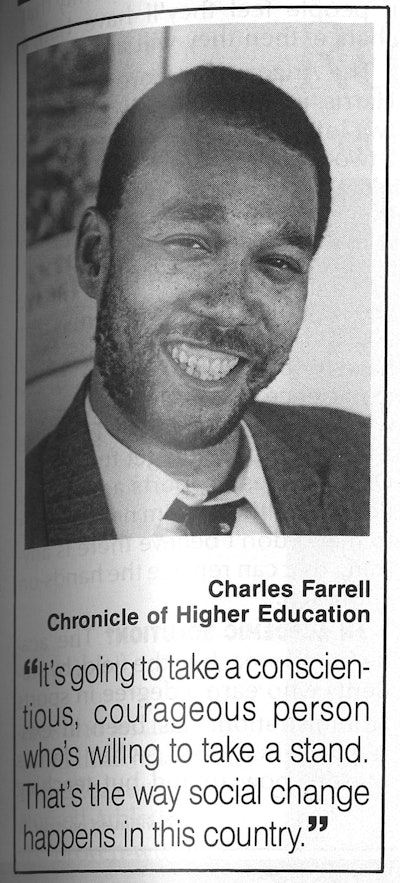
Media Spotlight
The media has played an important part, according to Charles Farrell, a reporter for the Chronicle of Higher Education, who for the past five years has written extensively on college sports issues.
“The scrutiny of the media is going to improve the situation,” says Farrell. “In both professional and college sports, the ‘old boy network’ has ruled things, making all their decisions behind the scenes, but with increased public attention, if black people are not considered for more responsible position, the negative headlines will have an effect. I don’t believe the people who are running the system, especially those in the colleges, will be willing to pay such a price.”
In response to what Farrell calls “an atmosphere created by the Reagan Administration, a backing away from affirmative action, there has developed almost an outrage, a fight-back effect that’s beginning to cut across racial lines.
“Blacks are saying they should be and must be a part of the total sports system, and there are enough conscientious whites to say if they’re going to recruit blacks for their football and basketball teams then they must also include them in their hierarchy.”
Farrell says that despite slow progress, initiatives by the NCAA are encouraging, “because if you’re talking about building a feeder system for professional coaches and administrators, the obvious place to start is on the college level.
“It’s not going to improve dramatically over the next several years, because this is America, and the realities of racism are there every day, but there is a dialogue taking place, and what we’re seeing today is the beginning of change.”

NCAA Executive Director Dick Schultz, since assuming his post last August, has repeatedly said that encouraging greater minority involvement should be a primary objective of the organization, and he points to the NCAA staff as an example.
According to NCAA personnel figures, nine of the 65 persons currently in administrative positions are from ethnic minority groups. As of December, according to Suzanne Mason, NCAA personnel manager, minority applicants have been selected in four of the past five hirings. Mason also notes that 22 of the administrators are women.
Last August, the NCAA Council, reacting to criticism of the overwhelming white makeup of the intercollegiate coaching and administrative structure, approved the formation of a special subcommittee to study the issue for a year and make recommendations. Heading the committee is Raymond Burse, a member of the Council and president of Kentucky State University, a historically black institution.
According to Burse, discussions have centered on four proposals:
- Develop a vita bank (a file of resumes for prospective candidates) at NCAA headquarters, utilizing that office as a clearinghouse for potential employees and employers.
- Broaden the job classifications the NCAA requires for inclusion on its committees, to encourage more minority involvement.
- Create a minority internship on the NCAA staff, while also encouraging member institutions to implement internships of their own.
- Provide NCAA funding from the general budget to assist interested persons in obtaining degrees in sports administration.
Plugging into the Network
Concurring with Farrell’s observation about the role of the “old boy network,” Burse says that vacancies tend to be filled by recommendations among people familiar with one another, so “what you end up with is the same people recycled.”
Burse says that in many cases it’s not so much a resistance to hiring blacks as it is a preference for hiring someone with experience at similar positions.
“There’s a level of comfort gained by going with someone who’s already been there, regardless of his or her record,” says Burse, “and there’s a tendency to believe you’re less likely to make a mistake.
“We’ve talked to some people who want opportunities, and what they say is, ‘We don’t want you to give us a job, but if you can just help us get that first interview, then we can take care of the rest.’ So, what we’re trying to do is to find ways to allow more minorities to plug into that network.”
The vita bank, says Burse, would help open up the process.
“Everybody, I think, is looking for the best possible people they can find to fill a position,” says Burse. “Most institutions will look at all sources available, and once they know the NCAA has a source, they will use it to their benefit.”
Internships Created
In partial response to the internship issue, the NCAA Executive Committee has approved a program that will make available to eligible Division I conferences grants ranging from $15,000 to $90,000 annually for the next three years, to be applied to three problem categories—basketball officiating, drug education, and compliance and enforcement—with an option included for enhancing minority employment.
All conferences meeting eligibility requirements are expected to apply, but since the program is just underway, and because minority employment is only listed as an opinion (contrasted with the mandate that some money must be spent in each of the other three categories), there is little indication of which conferences intend to spend money for what. However, two conferences with progressive traditions, the Big Ten and Pac-10, have already announced that they will allocate part of the funding for minority interns.
The Pac-10, in fact, already has a minority internship, with Justina Boyd, a former student-athlete from the University of Arizona, employed on the conference staff. The internship is funded this year through the conference budget, but in the next two years, the conference will make use of the NCAA funds.
Among the areas in which the intern will work are administration, budget, compliance and eligibility, public relations and individual sport programs, with the aim of providing a well-
Two Big Ten internships, one for a minority male and one for a woman, have recently been created, following a recommendation by the conference’s Advisory Commission, which is made up of one prominent black athlete/graduate from each Big Ten school.
Formed in 1972 to deal with racism on Big Ten campuses, the commission has, among other things, pushed for hiring more black officials, and was also instrumental in the Big Ten’s
1974 decision to hire the late Charles D. Henry, the first black in the country to serve as an assistant conference commissioner.
His successor, Clarence Underwood, also is black.
The Big Ten has had a general internship program for several years, but the new program, known as the Charles D. Henry Fellowship, will be expressly tailored for that purpose.
“We’re looking for people with limited professional experience in athletics,” says Underwood. “They’ll work for us in a variety of capacities for a year, then the conference will try to place them elsewhere.
“Athletics is a funny kind of entity, you know. People are extremely loyal to each other, and the circles they run in are not very open to people outside. A good internship program is one way that a qualified person might ease his or her way through the door.
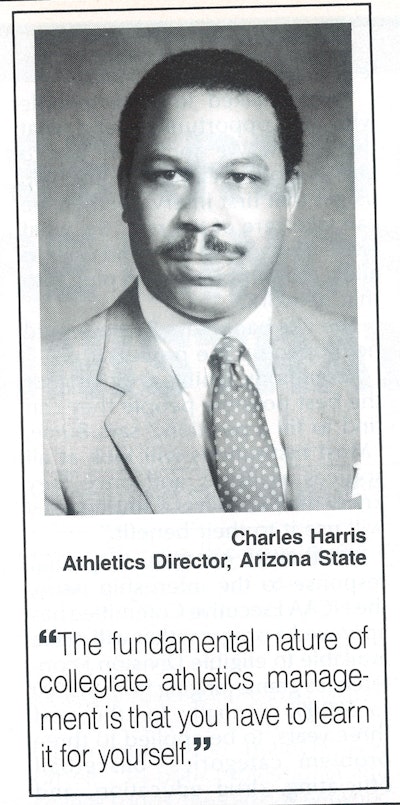
Hands-On Experiences
Arizona State’s athletics department, headed by Charles Harris, one of only a handful of black athletics directors at predominantly white schools, has its own internship program.
(Arizona State also holds the distinction of being the only predominantly white Division I school with both a black A.D. and a black associate A. D., Herman Frazier, who serves as the primary women’s athletics administrator.)
Although the internships at Arizona State are not set up specifically for minorities, Harris has instructed his administrators to focus attention on minority and women candidates.
“The issue is awareness,” says Harris. Prospective candidates who believe their application will receive only cursory review “are not going to bother,” but “I believe firmly that if people feel they’ll have half a chance, then they will apply.”
The Arizona State program, says Harris, is comprehensive, allowing two interns to gain experience over a two-year period. When they complete the internship, he believes, they are well qualified to move on to a responsible position.
The fundamental nature of collegiate athletics management is that it can’t be taught, says Harris. “You have to learn it for yourself. In my experience, these are the people who do best in the field. There are a lot of people who get turned out with degrees in sports administration, and although I’m not opposed to that, I don’t believe there is anything that can replace the hands-on approach.”
An Academic Solution?
The academic approach to the field, by the students who earn a degree in sports administration, has been in existence since 1966, when James Mason, now retired but teaching part-time at Texas-El Paso, organized the first such program at Ohio University with the help of then-Dodger executive Walter O’Malley.
One of the better known of the more than 100 sports administration programs in the country, Ohio University’s program requires all students to take on-the-job training.
According to Charles Higgins, program director for the last 11 years, most of his program’s students have been successful in landing internships and employment after graduation. Of the 480 graduates since the program was started, however, only nine have been from ethnic minority groups. Of these, three have taken jobs in college sports administration.
Higgins notes that all nine minority graduates have gone through the program since 1977, indicating that the academic approach may have become more attractive, but he has no ready answer for why the number of minority students has remained low.
To help remedy the situation, Higgins has actively recruited minority students for the past two years and has provided one minority student each year with scholarship money. He also points to the beginnings of scholarship opportunities provided by professional clubs and private industry as another possible aid.
In addition, the NCAA Executive Committee has approved a $200,000 scholarship program, beginning in 1988-89, for sports administration students, with particular emphasis on minority students.
Qualified Candidates Exist
While sports administration and internship programs may provide a long-term influx of qualified minority administrators, some observer maintain that there is already a pool of qualified talent that deserves consideration for current high-level openings. What’s needed, they say, is institutional leadership.
“We can make our recommendations,” says Burse, “but there’s only so much the (NCAA) leadership is able to do. You have to keep in mind that the NCAA is an association of member institutions, and it cannot impose anything on those institutions that they don’t want imposed. I see it, therefore, as more of an institutional problem
“One of the things we’re attempting to say to the chief executive officers of those institutions is that there is a responsibility on their part to make opportunities available, and that minorities must be seriously considered for those positions. If they’re willing to do that, then it ought to come about.”
Prentice Gautt, assistant commissioner of the Big Eight Conference, who was hired in 1979 by former commissioner Chuck Neinas, now executive director of the College Football 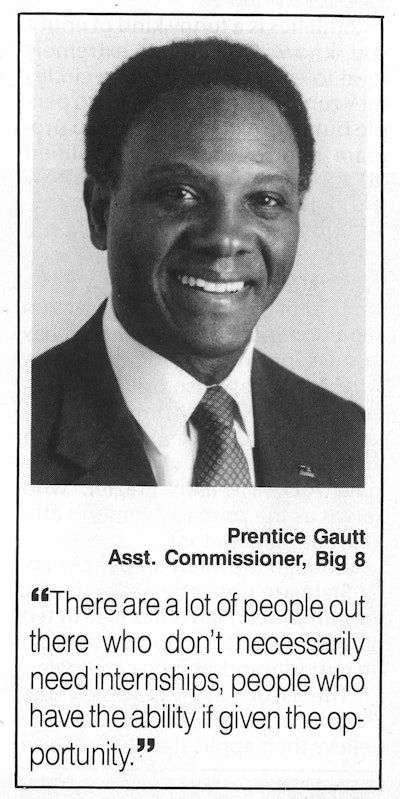
“There are a lot of people out there who don’t necessarily need internships, people who have the ability if given the opportunity,” says Gautt. “If someone says, ‘Hey, I believe you can do this, and I’m employing you to do it,’ there are a lot of people out there who can.”
A case in point, says Gautt, is Doug Johnson, a former NCAA legislative assistant and investigator who is now assistant A.D. at the University of Miami. Provided with an opportunity to gain some exposure as an NCAA investigator, making contacts and demonstrating his abilities in the field, he made the jump to an administrative position in less than a year.
Similarly, Michael Garnes, who is currently completing his master’s degree in sports administration at the University of New Mexico, is a former NCAA investigator who recently formed his own company, Intercollegiate Athletic Consultants, drawing on contacts he made during his NCAA employment
“You’ve just got to be placed in those situations so people can see what you can do,” says Gautt, “because it’s who knows you and who is power is willing to take a risk.”
“It has to come from the top,” says Farrell of the Chronicle of Higher Education. “It could be a president or it could be an athletics director, but whoever it is, it’s going to take a conscientious, courageous person who’s willing to take a dramatic stand. That’s the way social change happens in this country.
“When Lyndon Johnson nominated Thurgood Marshall for the Supreme Court, he knew exactly what he was doing. He was making a weighty statement.”



















